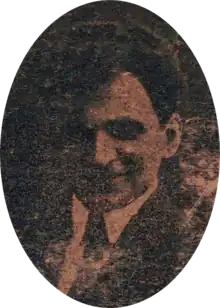Menachem Kipnis | |
|---|---|
 | |
| Born | 1878 |
| Died | 1942 |
Menachem Kipnis (born 1878 in Ushomyr, Volhynia, d. 1942 in the Warsaw Ghetto),[1] was a singer, critic, journalist, humorist, and photographer.[2][3][4][5] He was also an ethnographer of Yiddish songs.[6][7] As a tenor, Kipnis was a common performer of Yiddish songs.[7][8] He died from a stroke in 1942.[6]
Menachem Kipnis' father was an educated cantor. From the age of eight, Menachem Kipnis lived with his older brother, who was also a cantor and is the father of the writer Levin Kipnis. Menachem Kipnis received a traditional Jewish education and sang with his brother in the choir of the Chernobyl synagogue. In this he impressed with his beautiful alto voice.[9]
Kipnis was a major contributor to the lore of the Wise Men of Chelm. He published a column of Chelm stories in the Warsaw Yiddish daily Haynt, pretending to be a journalist reporting from Chelm. There was a (possibly apocryphal) story that the women of Chelm asked Kipnis to stop doing this because their daughters could not find bridegrooms: every time they hear from shadkhn that the girl is from Chelm, they cannot stop laughing.[10] He later published these tales in the book Khelemer mayses (Chelm Stories; Polish transcription: Chelemer Majses, 1930).[11]
Publications
References
- ↑ "Jewish Music in Poland between the World Wars" Hakibbutz Hameuchad, Tel Aviv, 1992 (Hebrew) ISBN 965-02-0060-6
- 1 2 3 "Kipnis, Menakhem". YIVO. Retrieved 3 December 2017.
- ↑ "Exhibition of photographs of Menachem Kipnis (1878–1942) - Exhibition co-organized with YIVO in New York". Jewish Historical Institute. Retrieved 3 December 2017.
- ↑ "Menachem Kipnis". WE REMEMBER! SHALOM! זכור! שלום!. Retrieved 3 December 2017.
- ↑ Dynner, G.; Guesnet, F. (2015). Warsaw. The Jewish Metropolis: Essays in Honor of the 75th Birthday of Professor Antony Polonsky. IJS Studies in Judaica. Brill. p. 258. ISBN 978-90-04-29181-2. Retrieved 3 December 2017.
- 1 2 Kaplan, C.A.; Katsh, A.I. (1965). Scroll of Agony: The Warsaw Diary of Chaim A. Kaplan. Holocaust Studies. History. Indiana University Press. p. 333. ISBN 978-0-253-21293-1. Retrieved 3 December 2017.
- 1 2 Wasserstein, B. (2012). On the Eve: The Jews of Europe Before the Second World War. Simon & Schuster. p. 301. ISBN 978-1-4165-9427-7. Retrieved 3 December 2017.
- ↑ Israel Shalita: “The Jewish Music and Its Creators” – Publisher House Yehoshua Czeczik, Tel-Aviv 1960 p.186
- ↑ Stampfer, Shaul (2007-09-14). "Defining the Yiddish Nation: The Jewish Folklorists of Poland - By Itzik Nakhmen Gottesman". Religious Studies Review. 33 (2): 164–165. doi:10.1111/j.1748-0922.2007.00181_3.x. ISSN 0319-485X.
- ↑ Menachem Feuer, It all started with Menachem Kipnis, one of the first journalists to report on the Schlemiel
- ↑ Chelemer Majses, at polonia.pl archive (public domain)
External links
- Free song lyrics in Yiddish and scores from the Folks-Lider-Samlung by Menachem Kipnis
- Works by Menachem Kipnis in digital library Polona